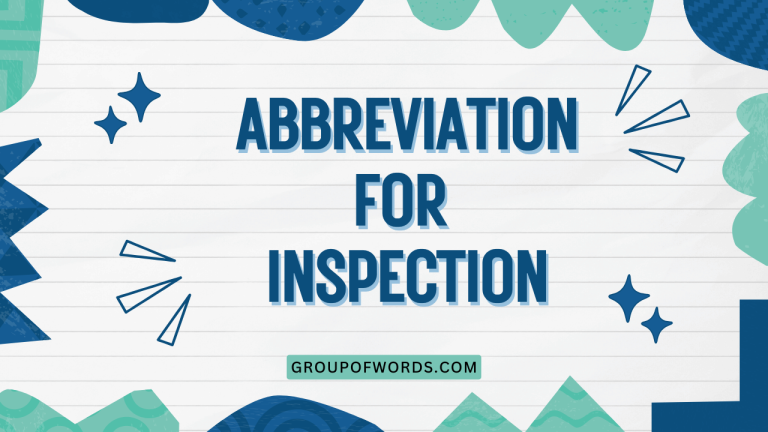“Replaced” Abbreviation: A Comprehensive Guide
Understanding abbreviations is crucial for efficient communication in various fields, from academic writing to technical documentation. One common abbreviation, used to indicate that something has been replaced, is essential for clarity and conciseness.
This article delves into the abbreviation for “replaced,” exploring its definition, usage, and practical applications. Whether you’re a student, a professional writer, or simply an English language enthusiast, mastering this abbreviation will enhance your writing and comprehension skills.
Table of Contents
- Introduction
- Definition of “Replaced” Abbreviation
- Structural Breakdown
- Types and Categories
- Examples of “Replaced” Abbreviation
- Usage Rules
- Common Mistakes
- Practice Exercises
- Advanced Topics
- FAQ
- Conclusion
Definition of “Replaced” Abbreviation
The abbreviation for “replaced” is most commonly “repl.” It is used to indicate that something has been substituted or superseded by something else. This compact form saves space and time, particularly in contexts where brevity is valued, such as footnotes, endnotes, technical manuals, and data tables. The abbreviation’s function is primarily to denote a change or substitution, providing crucial information about the evolution or modification of a particular subject or item.
In academic contexts, “repl.” might be used in citations to show that a later edition of a work has superseded an earlier one. In technical fields, it could indicate that a component has been upgraded or exchanged for a newer model.
The abbreviation is straightforward and widely recognized, making it a valuable tool for clear and concise communication.
Structural Breakdown
The abbreviation “repl.” is a shortened form of the word “replaced.” It follows a simple structural pattern:
- Root word: The root word is “replace.”
- Suffix removal: The suffix “-ed” is removed from “replaced.”
- Abbreviation: The remaining letters are shortened to “repl.” followed by a period.
The period at the end of “repl.” signals that it is an abbreviation and not the complete word. This convention is important for maintaining clarity and avoiding confusion, especially in formal writing.
The structure is consistent and easily recognizable, contributing to the abbreviation’s widespread use and understanding.
Types and Categories
While the abbreviation “repl.” itself doesn’t have distinct types, its usage can be categorized based on the context in which it is applied. Here are some common categories:
1. Academic Writing
In academic papers, “repl.” is often used in footnotes or endnotes to indicate that a source has been updated or superseded by a newer edition. It can also be used to show that a particular theory or concept has been revised or replaced by a more recent one.
2. Technical Documentation
Technical manuals and documentation frequently use “repl.” to denote that a component, part, or procedure has been replaced with an updated version. This is crucial for maintenance, repairs, and upgrades.
3. Data Tables and Spreadsheets
In data tables and spreadsheets, “repl.” can indicate that a particular data point has been updated or corrected with new information. This is important for maintaining the accuracy and reliability of the data.
4. Historical Records
Historical documents and records may use “repl.” to show that a particular item, term, or practice has been replaced by a more modern equivalent. This helps to contextualize historical information and understand changes over time.
5. General Writing
In general writing, “repl.” can be used in any context where it is necessary to indicate that something has been substituted or superseded. However, it is generally more common in formal or technical writing than in casual conversation.
Examples of “Replaced” Abbreviation
The following tables provide numerous examples of how “repl.” is used in different contexts. Each table focuses on a specific category to illustrate the versatility of the abbreviation.
Table 1: Academic Writing Examples
This table showcases the use of “repl.” in academic writing, particularly in citations and footnotes, to indicate updated or superseded sources.
| Context | Example Sentence | Explanation |
|---|---|---|
| Citation | Smith (2005, repl. 2015) argues that… | Indicates that Smith’s 2005 publication has been replaced by a 2015 edition. |
| Footnote | See Jones (1998, repl. 2008) for a more detailed analysis. | Refers the reader to the 2008 edition of Jones’s work, which replaces the 1998 edition. |
| Endnote | The original theory (Miller, 1970) has been repl. by a more recent model (Chen, 2010). | Indicates that Miller’s 1970 theory has been superseded by Chen’s 2010 model. |
| Historical Analysis | The term “alchemy” (repl. “chemistry” in the 18th century) reflects a shift in scientific methodology. | Shows that the term “alchemy” was replaced by “chemistry” during the 18th century. |
| Literature Review | Early studies (e.g., Brown, 1960) have been largely repl. by more comprehensive research. | Indicates that Brown’s 1960 studies have been superseded by more recent research. |
| Citation | Johnson (1990, repl. 2000) provides a revised perspective on the topic. | The 2000 edition of Johnson’s work replaces the 1990 edition. |
| Footnote | For updated information, see Davis (2003, repl. 2013). | Refers to the 2013 edition of Davis’s work, which is an updated version of the 2003 edition. |
| Endnote | The initial hypothesis (White, 1985) has been repl. by a more accurate model. | White’s 1985 hypothesis has been replaced by a more accurate model. |
| Historical Analysis | The concept of “phlogiston” (repl. by oxygen theory) marked a significant change in chemistry. | The concept of “phlogiston” was replaced by the oxygen theory. |
| Literature Review | Previous findings (e.g., Green, 1975) have been largely repl. by current studies. | Green’s 1975 findings have been superseded by current studies. |
| Citation | Anderson (2001, repl. 2011) offers a contemporary analysis of the subject. | The 2011 edition of Anderson’s book replaces the 2001 edition. |
| Footnote | Consult Thompson (1995, repl. 2005) for an overview of the historical context. | Refers the reader to the 2005 edition of Thompson’s work. |
| Endnote | The older algorithm (Clark, 1980) has been repl. by a more efficient method. | Clark’s 1980 algorithm has been replaced by a more efficient method. |
| Historical Analysis | The geocentric model (repl. by the heliocentric model) revolutionized astronomy. | The geocentric model was replaced by the heliocentric model. |
| Literature Review | Outdated methods (e.g., Hall, 1965) have been largely repl. by modern techniques. | Hall’s 1965 methods have been superseded by modern techniques. |
| Citation | Moore (2008, repl. 2018) presents an updated evaluation of the data. | The 2018 edition of Moore’s book replaces the 2008 edition. |
| Footnote | See Wilson (1992, repl. 2002) for a detailed examination of the topic. | Refers the reader to the 2002 edition of Wilson’s work. |
| Endnote | The original framework (Baker, 1978) has been repl. by a more comprehensive structure. | Baker’s 1978 framework has been replaced by a more comprehensive structure. |
| Historical Analysis | The term “ether” (repl. by field theories) demonstrates the evolution of physics. | The term “ether” was replaced by field theories. |
| Literature Review | Prior research (e.g., Carter, 1955) has been largely repl. by contemporary studies. | Carter’s 1955 research has been superseded by contemporary studies. |
Table 2: Technical Documentation Examples
This table demonstrates the use of “repl.” in technical documentation to indicate that a component or procedure has been updated.
| Context | Example Sentence | Explanation |
|---|---|---|
| Component Replacement | Part A (repl. by Part B) is required for the upgrade. | Indicates that Part A has been replaced by Part B for the upgrade. |
| Software Update | Version 1.0 (repl. by Version 2.0) includes enhanced security features. | Shows that Version 1.0 has been replaced by Version 2.0, which has enhanced security. |
| Procedure Update | The old procedure (repl. by the new procedure) requires different tools. | Indicates that the old procedure has been replaced by a new procedure, which uses different tools. |
| Hardware Upgrade | The original CPU (repl. by a faster model) improves performance. | Shows that the original CPU has been replaced by a faster model to improve performance. |
| Firmware Update | Firmware version 1.2 (repl. by version 1.3) addresses several bugs. | Indicates that Firmware version 1.2 has been replaced by version 1.3, which fixes bugs. |
| Component Replacement | Sensor X (repl. by Sensor Y) provides more accurate readings. | Sensor X has been replaced by Sensor Y for more accurate readings. |
| Software Update | System A (repl. by System B) offers improved functionality. | System A has been replaced by System B, which has improved functionality. |
| Procedure Update | The initial method (repl. by the revised method) streamlines the process. | The initial method has been replaced by a revised method. |
| Hardware Upgrade | The previous GPU (repl. by a newer model) enhances graphics capabilities. | The previous GPU has been replaced by a newer model. |
| Firmware Update | Firmware version 2.1 (repl. by version 2.2) includes critical security patches. | Firmware version 2.1 has been replaced by version 2.2. |
| Component Replacement | Module A (repl. by Module B) is necessary for optimal performance. | Module A has been replaced by Module B for optimal performance. |
| Software Update | Application X (repl. by Application Y) provides a better user experience. | Application X has been replaced by Application Y. |
| Procedure Update | The original protocol (repl. by the updated protocol) improves efficiency. | The original protocol has been replaced by an updated protocol. |
| Hardware Upgrade | The old RAM (repl. by a larger capacity RAM) speeds up processing. | The old RAM has been replaced by a larger capacity RAM. |
| Firmware Update | Firmware version 3.0 (repl. by version 3.1) enhances system stability. | Firmware version 3.0 has been replaced by version 3.1. |
| Component Replacement | Unit X (repl. by Unit Y) is crucial for the system upgrade. | Unit X has been replaced by Unit Y. |
| Software Update | Program A (repl. by Program B) offers advanced features. | Program A has been replaced by Program B. |
| Procedure Update | The initial step (repl. by the simplified step) reduces errors. | The initial step has been replaced by a simplified step. |
| Hardware Upgrade | The previous motherboard (repl. by a newer one) improves compatibility. | The previous motherboard has been replaced by a newer one. |
| Firmware Update | Firmware version 4.1 (repl. by version 4.2) addresses performance issues. | Firmware version 4.1 has been replaced by version 4.2. |
Table 3: Data Tables and Spreadsheets Examples
This table provides examples of using “repl.” in data tables and spreadsheets to indicate updated or corrected data points.
| Context | Example Entry | Explanation |
|---|---|---|
| Sales Data | Q1 Sales: $10,000 (repl. with $12,000) | Indicates that the original Q1 sales figure of $10,000 has been replaced with the corrected figure of $12,000. |
| Inventory Count | Item X: 50 units (repl. with 60 units) | Shows that the original inventory count of 50 units has been replaced with the updated count of 60 units. |
| Customer Data | Address: 123 Main St (repl. with 456 Oak Ave) | Indicates that the customer’s address has been updated from 123 Main St to 456 Oak Ave. |
| Financial Data | Revenue: $500,000 (repl. with $550,000) due to audit findings. | Shows that the original revenue figure of $500,000 has been replaced with $550,000 after an audit. |
| Scientific Data | Measurement: 25°C (repl. with 26°C) after recalibration. | Indicates that the original measurement of 25°C has been replaced with 26°C after recalibration. |
| Sales Data | July Sales: $15,000 (repl. with $17,000) | The original July sales figure of $15,000 has been updated to $17,000. |
| Inventory Count | Product Y: 75 units (repl. with 80 units) | The original inventory count of Product Y has been replaced with 80 units. |
| Customer Data | Email: [email protected] (repl. with [email protected]) | The customer’s email address has been updated. |
| Financial Data | Expenses: $20,000 (repl. with $22,000) after reconciliation. | The original expense figure has been replaced with $22,000. |
| Scientific Data | Value: 3.14 (repl. with 3.14159) for increased precision. | The value has been updated for increased precision. |
| Sales Data | August Sales: $20,000 (repl. with $23,000) due to revised data. | The original August sales figure has been updated. |
| Inventory Count | Item Z: 100 units (repl. with 105 units) after stocktaking. | The original inventory count of Item Z has been updated. |
| Customer Data | Phone: 555-1234 (repl. with 555-5678) | The customer’s phone number has been updated. |
| Financial Data | Assets: $100,000 (repl. with $110,000) after revaluation. | The original asset figure has been updated. |
| Scientific Data | Result: 1.5 (repl. with 1.55) after additional testing. | The result has been updated after additional testing. |
| Sales Data | September Sales: $25,000 (repl. with $28,000) after corrections. | The original September sales figure has been updated. |
| Inventory Count | Product A: 125 units (repl. with 130 units) after inventory check. | The original inventory count of Product A has been updated. |
| Customer Data | City: Oldtown (repl. with Newtown) | The customer’s city has been updated. |
| Financial Data | Liabilities: $50,000 (repl. with $55,000) after audit adjustments. | The original liability figure has been updated. |
| Scientific Data | Rate: 0.05 (repl. with 0.055) after recalculation. | The rate has been updated after recalculation. |
Usage Rules
Using “repl.” correctly involves adhering to a few key rules:
- Always include the period: The period is essential to indicate that “repl.” is an abbreviation.
- Use in formal contexts: “repl.” is generally more appropriate for formal or technical writing, rather than casual communication.
- Clarity is key: Ensure that the context makes it clear what is being replaced and what it is being replaced by.
- Consistency: Maintain consistency in your use of abbreviations throughout a document.
While “repl.” is widely recognized, it’s important to consider your audience and the overall tone of your writing. In some cases, using the full word “replaced” may be preferable for clarity or to avoid an overly technical tone.
Common Mistakes
Several common mistakes can occur when using “repl.” Here are a few examples to help you avoid these errors:
| Incorrect | Correct | Explanation |
|---|---|---|
| Smith (2005 repl 2015) | Smith (2005, repl. 2015) | Missing period after “repl.” |
| The old version was repl by the new one. | The old version was repl. by the new one. | Missing period and incorrect sentence structure. |
| repl: Version 2.0 | repl. by Version 2.0 | Incorrect usage; should specify what is being replaced. |
| replaced with new version (repl) | replaced with new version (repl. by new version) | Unclear what is being replaced; needs context. |
| Part A repl Part B | Part A repl. by Part B | Missing period and preposition “by.” |
| Smith (2005, replaced 2015) | Smith (2005, repl. 2015) | Using the full word “replaced” when the abbreviation is appropriate. |
| The initial step repl the second step. | The initial step repl. by the second step. | Using “repl” as a verb rather than an abbreviation. |
| Q1 Sales: $10,000 repl $12,000 | Q1 Sales: $10,000 (repl. with $12,000) | Missing period and preposition “with.” |
| Firmware version 1.2 repl version 1.3 | Firmware version 1.2 repl. by version 1.3 | Missing period and preposition “by.” |
| Item X: 50 units repl 60 units | Item X: 50 units (repl. with 60 units) | Missing period and preposition “with.” |
Practice Exercises
Test your understanding of “repl.” with these practice exercises. Fill in the blanks with the correct abbreviation or full word where appropriate.
Exercise 1
- The outdated software has been _______ by a newer version.
- See Johnson (1990, _______ 2000) for a revised perspective.
- The original plan was _______ with a more efficient strategy.
- Part A (_______ by Part B) is required for the upgrade.
- The term “alchemy” (_______ by “chemistry”) reflects a shift in scientific methodology.
- The older algorithm (Clark, 1980) has been _______ by a more efficient method.
- Previous findings have been largely _______ by current studies.
- Consult Wilson (1992, _______ 2002) for a detailed examination.
- The concept of “phlogiston” (_______ by oxygen theory) marked a significant change.
- Outdated methods have been largely _______ by modern techniques.
Exercise 2
- Complete the sentence: “The original data (_______ with updated data) provides a clearer picture.”
- Correct the sentence: “The initial method repl the revised method.”
- Fill in the blank: “Version 1.0 (_______ by Version 2.0) includes enhanced features.”
- Correct the sentence: “The old procedure repl by the new procedure requires different tools.”
- Complete the sentence: “The geocentric model (_______ by the heliocentric model) revolutionized astronomy.”
- Fill in the blank: “The previous GPU (_______ by a newer model) enhances graphics.”
- Correct the sentence: “The original framework repl by a more comprehensive structure.”
- Complete the sentence: “The term ‘ether’ (_______ by field theories) demonstrates the evolution of physics.”
- Fill in the blank: “The initial hypothesis (_______ by a more accurate model) changes the understanding.”
- Correct the sentence: “The outdated software repl with a newer version improves the system.”
Answer Key
Exercise 1 Answers
- replaced
- repl.
- replaced
- repl.
- repl.
- repl.
- replaced
- repl.
- repl.
- replaced
Exercise 2 Answers
- repl.
- The initial method repl. by the revised method.
- repl.
- The old procedure repl. by the new procedure requires different tools.
- repl.
- repl.
- The original framework repl. by a more comprehensive structure.
- repl.
- repl.
- The outdated software repl. with a newer version improves the system.
Advanced Topics
For advanced learners, understanding the nuances of abbreviation usage and historical context can be beneficial. Here are some advanced topics related to “repl.”:
1. Historical Evolution of Abbreviations
Explore how abbreviations have evolved over time and across different fields. Understanding the historical context can provide insight into the conventions and practices that govern abbreviation usage today.
For example, research the history of abbreviations in scientific writing or legal documents.
2. Cross-Disciplinary Usage
Investigate how “repl.” and similar abbreviations are used in various disciplines, such as medicine, engineering, and law. Each field may have its own specific conventions and guidelines for using abbreviations, so understanding these differences can enhance your professional communication skills.
3. Stylistic Considerations
Consider the stylistic implications of using abbreviations in different types of writing. While abbreviations can save space and time, they can also make writing seem overly technical or impersonal.
Learn how to balance the need for brevity with the importance of clarity and readability.
4. Alternative Abbreviations
While “repl.” is a common abbreviation for “replaced,” other abbreviations or phrases may be used in specific contexts. For example, “superseded,” “updated,” or “revised” could be used instead of “replaced.” Understanding these alternatives can help you choose the most appropriate term for your writing.
FAQ
Here are some frequently asked questions about the abbreviation “repl.”:
- What does “repl.” stand for?
“Repl.” is the abbreviation for “replaced.” It is used to indicate that something has been substituted or superseded by something else.
- Is it necessary to include the period after “repl.”?
Yes, the period is essential because it signals that “repl.” is an abbreviation and not the complete word. Omitting the period can lead to confusion and misinterpretation.
- In what contexts is “repl.” commonly used?
“Repl.” is commonly used in academic writing, technical documentation, data tables, and historical records. It is particularly useful in situations where brevity is important.
- Is “repl.” appropriate for casual writing?
While “repl.” can be used in general writing, it is generally more appropriate for formal or technical contexts. In casual writing, using the full word “replaced” may be preferable.
- What is the correct way to use “repl.” in a sentence?
Ensure that the context makes it clear what is being replaced and what it is being replaced by. For example, “Part A (repl. by Part B) is required for the upgrade.”
- Are there any alternatives to using “repl.”?
Yes, alternatives include “superseded,” “updated,” or “revised.” The choice depends on the specific context and the nuance you want to convey.
- Can I use “repl” as a verb in a sentence?
No, “repl.” is an abbreviation for the past participle “replaced” and should not be used as a verb. Use “replaced” instead.
- How can I ensure that I am using “repl.” correctly?
Always include the period, use it in formal contexts, ensure clarity, and maintain consistency throughout your writing. Review examples and practice exercises to reinforce your understanding.
Conclusion
Mastering the abbreviation “repl.” is a valuable skill for anyone who wants to communicate effectively in formal or technical contexts. By understanding its definition, usage rules, and common mistakes, you can confidently incorporate it into your writing.
This knowledge enhances clarity and conciseness, making your communication more efficient and professional.
Remember to practice using “repl.” in various contexts to solidify your understanding. With consistent application, you’ll find that this abbreviation becomes a natural part of your writing repertoire.
Embrace the opportunity to refine your grammar skills and elevate the quality of your written communication.






